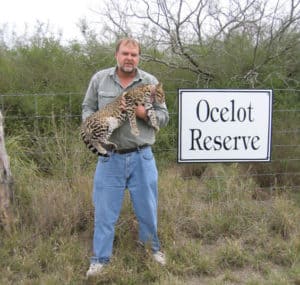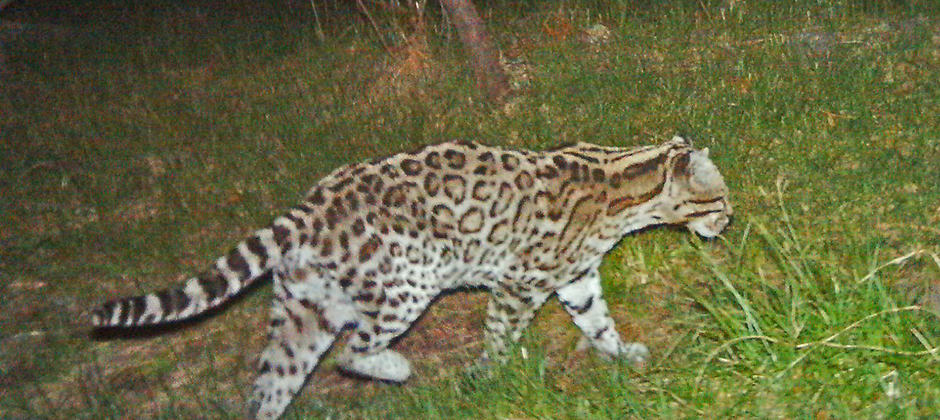Share this article
Is time running out for the ocelot?
In his 35 years studying ocelots (Leopardus pardalis), 42-year TWS member Michael Tewes has seen plenty of efforts to conserve them in his home state of Texas, but they haven’t had much success. The endangered wild cat, a tawny and spotted animal weighing about 20 pounds, continues to struggle, despite expanding refuges, road-crossing structures and other efforts undertaken to help them survive.
“We’re missing the target,” said Tewes, the Frank D. Yturria endowed chair in wild cat studies and regents professor at the Caesar Kleberg Wildlife Research Institute at Texas A&M University-Kingsville. “It’s like we’re throwing darts at a bull’s-eye and we’re hitting the area on the outer circle. I’m urging that we start hitting the bull’s-eye.”
Invited by the Kingsville campus to deliver the annual faculty lecture there, Tewes threw his darts at where he believes Texas ocelot conservation is “on the wrong track,” and where it ought to focus on saving the species before its time runs out.
“If we’re not able to increase the carrying capacity to sustain the ups and downs that occur with population variability, they’re likely to disappear within the next 50 years,” Tewes said.
Ocelots range deep into South America, but they’re imperiled in every country in which they’re found. In the United States, they occur in only Arizona and Texas, both of which list them as species of greatest conservation need. A few male individuals have been spotted in Arizona. The only known breeding population in the U.S. lives in the Lower Rio Grande Valley of South Texas, distantly isolated from larger populations across the border in Mexico.
Tewes estimates fewer than 80 individuals roam the Texas thornscrub. The Laguna Atascosa National Wildlife Refuge typically supports seven to 14 individuals, Tewes believes. The rest occupy private ranchlands. Yet most recovery efforts are focused in and around the refuge area.

Longtime TWS member Michael Tewes has studied ocelots for 35 years. Image courtesy of Michael Tewes.
In his presentation, Tewes called for an “ecologically equivalent ‘Manhattan Project’ for ocelot recovery,” focusing less on one refuge and more on the handful of ranches where most of the cats occur. It would be a uniquely Texas approach, designed for a state where 97 percent of the land is in private hands.
Most ranchers are willing to help conserve the ocelot, he said, but they’re wary of government regulations. If conservation efforts could ensure that the few ranchers whose land hosts ocelots could maintain their operations while protecting the species, he believes, ocelots might have their best shot at recovery.
“I’m really trying to emphasize a much more strategic and targeted approach for ocelot recovery,” he said. “It comes down to the 80 percent of the ocelot population that occurs on private lands that have mostly been ignored for the past century.”
The Laguna Atascosa refuge is mostly surrounded by open coastal prairies, wetlands and increasing urbanization, which offers little chance for the refuge population to grow, Tewes said. Four efforts focused there — landscape corridors, habitat restoration, road-crossing structures and translocation efforts — have failed to provide a meaningful benefit, Tewes concluded, or made a significant difference for ocelot recovery. Instead, they offered an “illusion of achievement,” he said, that cost millions of dollars while habitat continues to decrease.
But while the refuges are isolated and surrounded by increasing urbanization, Tewes believes the ranches still offer ample resources for ocelots.
“Private land provides native rangelands with cover and prey,” he said. “The habitats are more interconnected. By definition, the ranches will be barriers to increasing roads and increasing human populations. They provide a security buffer decades into the future, which is in stark contrast to the refuge population.”
Tewes grew up in Odem, 35 miles north of Kingsville. He began working with ocelots in 1981, during the first year of the Caesar Kleberg Wildlife Research Institute’s operations. The most important day of his professional life, he says, was March 2, 1982, when he trapped his first ocelot. Since then, he said, habitat for the ocelot seems to have decreased, and their numbers likely have, too.
“Time is extremely limited for ocelot survival in the United States,” he wrote. “Empowering private landowners to enact a management plan for the ranch ocelot population, one that is tailored for ranchers, is the essence of the new paradigm for ocelot recovery.”
Header Image: Without more effective conservation efforts, Texas researcher Michael Tewes believes, Texas’ ocelot population is likely to be extinct in 50 years. ©Tom Smylie/USFWS








